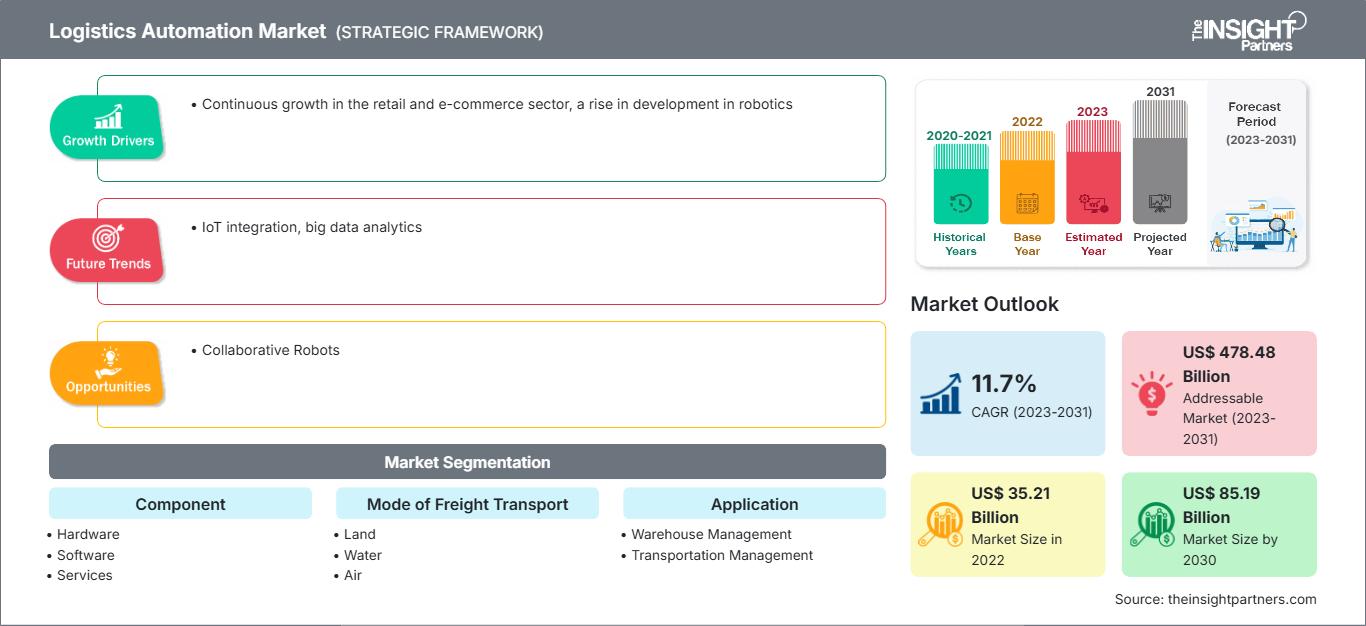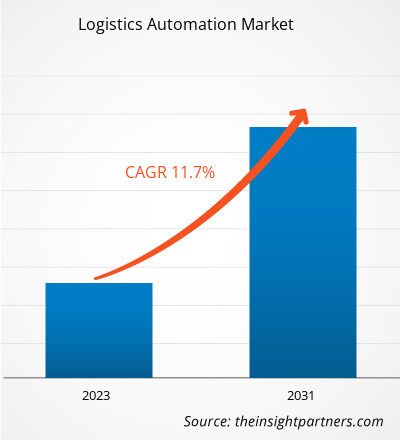预计到 2030 年,物流自动化市场规模将从 2022 年的 352.1 亿美元增至 851.9 亿美元。预计该市场在 2022 年至 2030 年期间的复合年增长率为 11.7%。物联网集成和大数据分析可能仍将是市场的主要趋势。
物流自动化市场分析
随着消费者期望的不断提高,市场参与者正专注于投资仓库的 IT 和运营功能。全球互联技术正在不断发展,科技公司涉足从分拣到整理等各个领域。他们正在利用最新的供应链技术和物联网 (IoT)。智能仓库是提高供应链流程效率和速度的枢纽。从工人佩戴的可穿戴设备到传感器和智能设备,联网设备和技术可以深刻地改变物流管理。仓库和运输管理部门正在积极采用物流自动化机器人,以实现整个供应链中货物的存储和移动自动化。物流自动化机器人集成在仓库和仓储设施中,用于组织和运输产品。与人工相比,这些机器人的正常运行时间更长,从而提高了行业的生产力和盈利能力。物流机器人的主要应用是部署在仓储设施和仓库中用于运输货物的移动式自动导引车 (AGV)。它们按照预定的路径运行,将产品运送到仓库并存储在不同的托盘中。AGV 有助于降低整体物流成本并高效简化供应链。因此,仓库中机器人技术的日益普及可能会对未来几年的物流自动化市场预测产生重大影响。
物流自动化市场概览
近年来,在物流自动化市场中,自动驾驶汽车在物流业务中的重要性日益提升,因为它们越来越多地被部署在仓库和堆场等精确控制的环境中。然而,在高速公路和城市街道等共享和公共场所部署自动驾驶汽车,可能是该行业在优化物流运营和提高安全性方面的下一个重大举措。人工智能技术的不断发展,以及传感器和视觉技术开发方面不断增加的巨额投资,可以为自动驾驶汽车的发展提供助力。自动驾驶汽车和无人机是自动化物流系统的重要组成部分。例如,谷歌和特斯拉在无人驾驶汽车技术方面取得了长足的进步。在过去的二十年里,得益于雷达技术和计算机能力的显著进步,自动驾驶已经从科幻小说发展成为切实可行的现实。由于便携式技术已经得到了充分的改进,超轻硬件能够基于自我改进的算法进行决策,工程师们更有可能在自动驾驶汽车中模拟人类的决策。
自定义此报告以满足您的要求
您将免费获得任何报告的定制,包括本报告的部分内容,或国家级分析、Excel 数据包,以及为初创企业和大学提供超值优惠和折扣
物流自动化市场: 战略洞察

- 获取本报告的主要市场趋势。这个免费样本将包括数据分析,从市场趋势到估计和预测。
您将免费获得任何报告的定制,包括本报告的部分内容,或国家级分析、Excel 数据包,以及为初创企业和大学提供超值优惠和折扣
物流自动化市场: 战略洞察

- 获取本报告的主要市场趋势。这个免费样本将包括数据分析,从市场趋势到估计和预测。
物流自动化市场驱动力与机遇
零售和电商行业持续增长,利好市场
物流自动化是电商的重要组成部分之一,用于管理库存、跟踪、包装、仓储和运输等问题。在零售和电商领域,企业有责任确保及时交付和退货政策。如果需要更换商品或产品,企业必须处理逆向物流的所有操作。在零售和电商领域,物流自动化提供商可以提供升级的技术、可扩展性、灵活性和效率。此外,电商行业正在蓬勃发展。例如,自2020年以来,印度的在线购物者已增加1.25亿,预计到2025年还将增加8000万。
物流自动化软件公司为零售和电商企业提供的物流需求和服务包括仓库管理、供应链管理、整合服务和订单履行。如果公司将物流需求外包给物流自动化服务提供商,则可以实现与电子商务相关的诸多优势。这使得零售和电商参与者能够各司其职。物流自动化公司专注于供应链管理,使在线商店能够专注于营销和其他业务运营。物流自动化软件使仓库经理能够高效处理各种流程,例如多线商品分拣、分箱拣选和码垛。因此,物流自动化软件在全球零售和电商领域拥有巨大的发展机遇。这将推动物流自动化市场的增长。
协作机器人
自从协作机器人被引入众多商业领域和行业流程以来,物流和仓储行业的生产力和效率得到了提升,使各种服务提供商能够满足不断增长的需求。协作机器人技术正在不断发展,随着工业4.0的兴起,供应链效率和仓储行业将继续受益。协作机器人的构造和设计旨在与人类在任何特定工作空间(例如仓库和配送中心)协作,因此它们能够执行多种功能,有助于降低人身伤害的风险。协作机器人的设计旨在利用人工智能 (AI) 和机器学习技术,实现高效、准确的工作。
物流自动化市场报告细分分析
促成物流自动化市场分析的关键细分领域包括组件、货运方式、应用和最终用户行业。
- 根据组件,物流自动化市场可分为硬件、软件和服务。 2022 年,硬件部分占有最大份额。
- 按货运方式,市场细分为陆运、水运和空运。
- 按应用,市场细分为仓库管理和运输管理。
- 按最终用户行业,市场细分为制造业、零售和电子商务、石油和天然气、食品和饮料、汽车、医疗保健和制药等。
按地域划分的物流自动化市场份额分析
物流自动化市场报告的地理范围主要分为五个地区:北美、亚太地区、欧洲、中东和非洲以及南美和中美洲。
2022 年,亚太地区是物流自动化市场增长最快的地区。亚太地区经济不断增长,带动了零售和电子商务、制造业、石油和天然气、食品和饮料、汽车和医疗保健等各个领域的增长。该地区对先进创新技术的采用率很高。由于各国政府为发展零售和电子商务行业而投入了大量资金并采取了各种举措,亚洲国家对物流自动化解决方案的部署也日益增多。
该地区拥有强大的电子商务产业。该地区的仓库正在采用尖端技术。此外,供应商产品数量的不断增长也促使仓库管理人员采用机器人技术和物流自动化软件,以实现系统化和可行的运营。亚洲新兴市场面临着市场竞争加剧、成本压力、通胀触发因素和市场波动等挑战。因此,供应链的规划和执行变得复杂。为了解决这些问题,制造商和供应商热切期待物流自动化服务,通过提高可视性和强化库存管理流程,最大限度地控制出站和入站供应链。
物流自动化物流自动化市场区域洞察
The Insight Partners 的分析师已详尽阐述了预测期内影响物流自动化市场的区域趋势和因素。本节还讨论了北美、欧洲、亚太地区、中东和非洲以及南美和中美洲的物流自动化市场细分和地域分布。
物流自动化市场报告范围
| 报告属性 | 细节 |
|---|---|
| 市场规模 2022 | US$ 35.21 Billion |
| 市场规模 2030 | US$ 85.19 Billion |
| 全球复合年增长率 (2023 - 2031) | 11.7% |
| 历史数据 | 2020-2021 |
| 预测期 | 2023-2031 |
| 涵盖的领域 |
By 组件
|
| 覆盖地区和国家 | 北美
|
| 市场领导者和主要公司简介 |
|
物流自动化市场参与者密度:了解其对业务动态的影响
物流自动化市场正在快速增长,这得益于终端用户需求的不断增长,而这些需求的驱动因素包括消费者偏好的不断变化、技术进步以及对产品优势的认知度不断提高。随着需求的增长,企业正在扩展其产品线,不断创新以满足消费者需求,并利用新兴趋势,从而进一步推动市场增长。

- 获取 物流自动化市场 主要参与者概述
物流自动化市场新闻和最新发展
物流自动化市场的评估是通过收集一手和二手研究后的定性和定量数据进行的,这些数据包括重要的公司出版物、协会数据和数据库。物流自动化市场的一些发展如下:
- 欧姆龙宣布在新加坡开设其首个物流自动化中心,以满足新加坡、东南亚和大洋洲客户的需求。(来源:欧姆龙,新闻稿,2022 年 12 月)
- FM Logistic 在印度开设了其第五个多客户工厂(也是第一个自有工厂)。(来源:FM Logistic,新闻稿,2022 年 5 月)
物流自动化市场报告内容和交付成果
“物流自动化市场规模和预测 (2020-2030)”报告对市场进行了详细的分析,涵盖以下领域:
- 物流自动化市场规模以及涵盖范围内所有关键细分市场的全球、区域和国家/地区预测
- 物流自动化市场趋势以及市场动态,例如驱动因素、限制因素和关键机遇
- 详细的 PEST/波特五力模型和 SWOT 分析
- 物流自动化市场分析涵盖关键市场趋势、全球和区域框架、主要参与者、法规和最新市场发展
- 行业格局和竞争分析涵盖市场集中度、热图分析、知名参与者和物流自动化市场的最新发展
- 详细的公司简介
- 历史分析(2 年)、基准年、预测(7 年)及复合年增长率
- PEST和SWOT分析
- 市场规模、价值/数量 - 全球、区域、国家
- 行业和竞争格局
- Excel 数据集
近期报告
相关报告
客户评价
购买理由
- 明智的决策
- 了解市场动态
- 竞争分析
- 客户洞察
- 市场预测
- 风险规避
- 战略规划
- 投资论证
- 识别新兴市场
- 优化营销策略
- 提升运营效率
- 顺应监管趋势




















 获取免费样品 - 物流自动化市场
获取免费样品 - 物流自动化市场